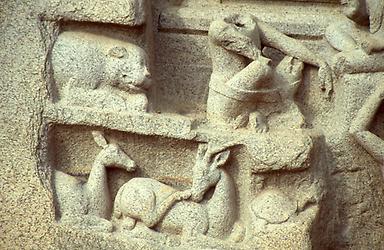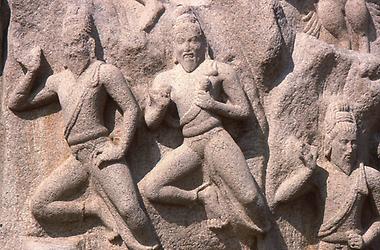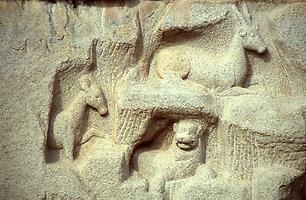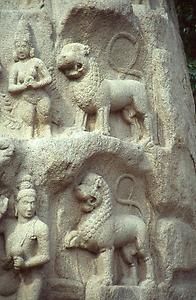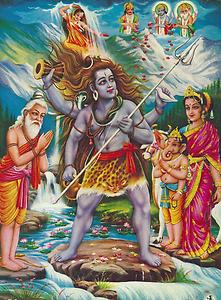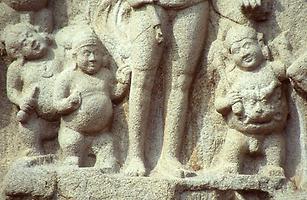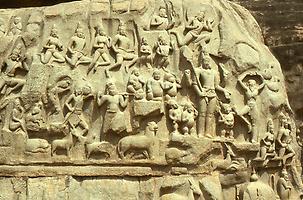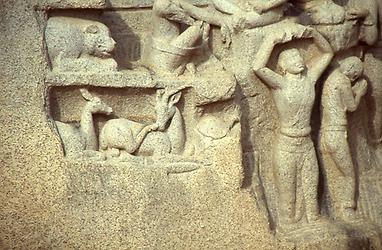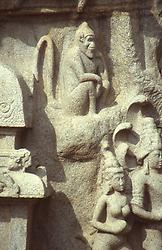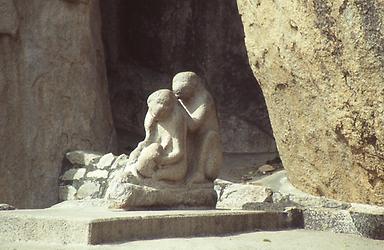Gods, humans and animmlas... and a miracle. #
The largest relief of the world "The Coming down of Ganga" in Mhabalipuram#
ByAll photos are from the author's archive "Picture-Flood".

On the Indian East coast, about 50 km South of Chennai (the former Madras) Indien, Chennai the city Mahabalipuram Indien, Mahabalipuram , capital of the province Tamil Nadu is located. The place is also sometimes called Mamallapuram.
The dynasty Pallava ruled this area from the 7 th to the 9 th century A.D. The most important king was probably king Mahendravarman (580-630), who also was called Mahamalla, "the powerful restler". This is also the reason for the second name of this modest sized city that has a number of important historic monuments all listed as UNESCO world heritage.
One of them is the probably largest relief every carved into a rock-wall: It shows the hinduistic myth of the arrival or origin of the river Ganga as deity, the "coming down of Ganga". It is displayed with unparalleld handicraft and artictic skills. Its length is 33 m and it is up to 12 m high. Hundreds of figures showing gods, people and animals are displayed looking at the mircale of the appearance of the river as it emergies from dry earth.
The interpetation is based on the lengendary belief that in times long ago earth was suffering a tremduous drought. In the Hinducsomos it is possible to almost force gods to fullfill any wish by performing penitantery rites. For this reason, king Bhagiratha practiced extreme ascesis. As a reuslt king Shiva granted his wish by again providing water for the dry earth. Siva commanded the godesss of rivers, Ganga, to drop herself (the river Ganges) onto the parched earth.
But, as this was about to happen, Bhagirathy realized that the powerfull impact of the river would destroy the world. Hence Shiva intervened, caught Ganga by clutching Ganga's hair. Shiva's powers were strong enougnh to force the river to search for an exit of the water through the hair, so eventually it could flow down in a tamed way to refresh the world.
In Sanskirt of old India this myth is called Gangavatara, the "Coming down of Ganges".
This artistic masterpiece is carved around a natural cleft in the rock representing the river. This is symbolized in that Indian cobras both as queens and kings of the waters are shown swimming. They have the body of a snake, but their upper torso is the one of rulers with crowns and jewellry. One can imagine that at the times of the Pallava dynasty water was fed into the crack at the top, so that the cobras, the Nagaranis and Nagarajas, would appear to the admiring crowd as actually swimming in the water. As special Navas they are distighuisehd by a mulit-part cobra head.
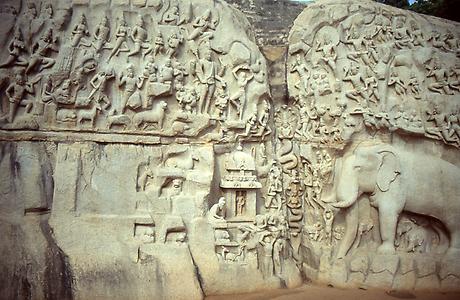
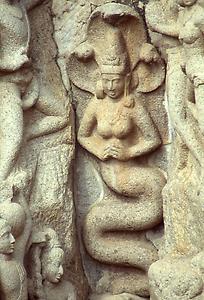

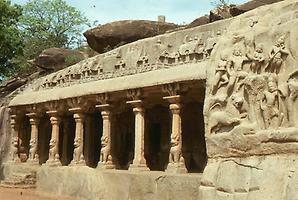


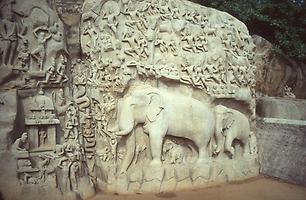
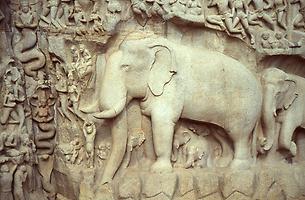
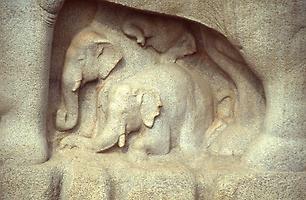
The right side of the relief does not extend as far as it could. This side is dominated by a family of elephants preceded by a bull. It is touching to observe how the young elephants are hiding under the body of their father.
All this is under the command of Shiva, recognicable by the ascetic cut of the hair und the trident that is powerful enough to make the earth tremble. Is it not interesting how one immediately sees a possible connection with the old Greek god Posseidon who used his trident to stir up wild waves in the sea when we wanted to? Shiva is in shear size larger than all humans, and within humans their size charaterizes their standing. Shiava is surrounded by Ganas, dwarfs with impressive bellies that belong to the follwoers of Siva's son Ganesha, the god with the head of an elephant.
King Bhagiratha in ascesic exercises is shown in the typical posture and the clothing of an old Indian penitent. He only wears a loincloth, is emaciated, stands on one foot and has his arms above his head, hands clasped.

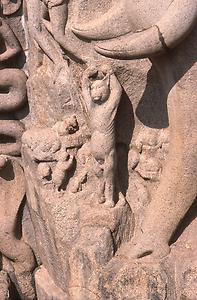
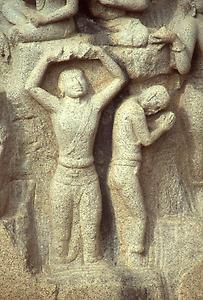
The relief shows other figures in ascetic poses or medidation. One person has a "medidation belt" over the knees to prevent collapsing when falling into a trance.
Another figure is sitting in a small temple looking at the picture of a deity. There are other figures that are human-like. Some represent gods, some justt plain people. Surprised gods come flying in to see the spectacle. Like in all old Indian pictures they are shown in "knee-flight", i.e. no with stretched out but rather angularly bent knees.
Also heavenly musicians, with the lower body bird-like, so-calles Kinnanras that live in the air, are depticted.
Among the mixture of gods and poeople also animals can be seen, with very lifelike stance and behaviour: The idea is clearly to present a picture of the whole world.
That this myth has remained alive till today is evident by pictures showing the "coming down of Gana" in the style of the 19 th century that are still in use today.
